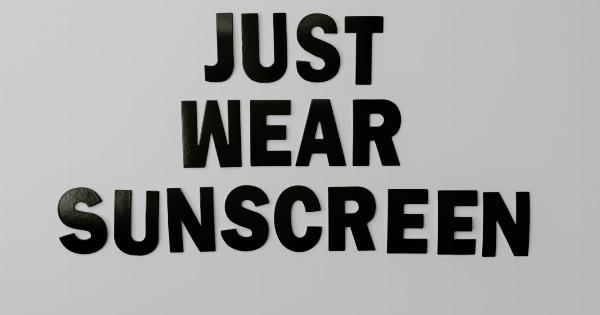We all love a sunny day – the warmth on our skin, the vitamin D boost, and the overall uplift in mood. However, as much as we enjoy the sun, it’s essential to acknowledge its dark side.
Sun exposure can have harmful effects on our skin and overall health if we’re not careful. In this article, we will separate fact from fiction and uncover the truth behind the potential dangers of prolonged and unprotected sun exposure.
1. The Link Between Sunburn and Skin Cancer
It is a widely known fact that sunburn increases the risk of developing skin cancer.
When our skin is exposed to the sun’s ultraviolet (UV) radiation for an extended period without protection, the DNA in our skin cells can become damaged, leading to mutations and the formation of cancerous cells. Skin cancer, including melanoma, is largely preventable by avoiding excessive sun exposure and applying sun protection measures such as sunscreen, protective clothing, and seeking shade during peak sun hours.
2. The Myth of a Healthy Tan
Despite the cultural glorification of a sun-kissed tan, it’s essential to debunk the myth that a tan is a sign of good health. A tan is actually a response to skin damage caused by UV radiation.
When our skin is exposed to the sun, it produces melanin, a pigment that darkens the skin, as a protective mechanism against further damage. However, no amount of tanning can make prolonged sun exposure safe. It’s crucial to prioritize skin health over the pursuit of a tan and embrace sunless tanning alternatives for a healthy glow.
3. Premature Aging and Wrinkles
Too much sun exposure can accelerate skin aging, leading to the premature development of wrinkles, fine lines, and age spots.
The sun’s UV rays penetrate the skin’s layers, breaking down collagen and elastin fibers responsible for maintaining skin’s elasticity. Over time, this leads to sagging, leathery skin with a less youthful appearance. Protecting our skin from the sun with sunscreen and avoiding excessive exposure can help delay signs of aging and keep our skin looking vibrant for longer.
4. Photodermatitis: Allergic Reactions to the Sun
Photodermatitis, also known as sun allergy, is an adverse skin reaction caused by exposure to sunlight. Some individuals may experience an itchy or painful rash, hives, or blistering when their skin is exposed to UV radiation.
Certain medications, fragrances, and even some plants can increase the sensitivity to sunlight. For those prone to photodermatitis, it’s crucial to take extra precautions by wearing protective clothing, using broad-spectrum sunscreen, and seeking shade, especially during peak sun hours.
5. Eye Damage and Vision Problems
The sun’s UV radiation doesn’t only affect our skin; it can also harm our eyes.
Prolonged exposure to UV rays without adequate eye protection can lead to various eye conditions, such as cataracts, macular degeneration, and even temporary or permanent vision loss. Wearing sunglasses with UV protection and a wide-brimmed hat can shield our eyes from harmful rays and reduce the risk of eye damage.
It’s essential to prioritize eye health and invest in quality sunglasses that block out 100% of both UVA and UVB radiation.
6. Sun Safety During Childhood
Childhood sun exposure plays a crucial role in the development of skin cancer later in life. The damage caused to the skin during childhood accumulates over time, resulting in an increased risk of developing skin cancer as an adult.
Parents and caregivers should take extra precautions to protect children from excessive sun exposure. This includes dressing them in sun-protective clothing, using sunscreen with a high SPF, limiting outdoor activities during peak sun hours, and teaching them good sun safety habits from an early age.
7. The Role of Vitamin D
While excessive sun exposure is harmful, it’s important to note that the sun also plays a crucial role in our body’s production of vitamin D. Vitamin D is essential for maintaining healthy bones, teeth, and immune function.
However, it’s a delicate balance – we need some sun exposure for vitamin D synthesis, but too much can cause harm. The best approach is to seek a balance by spending limited time outdoors during non-peak sun hours and ensuring a diet rich in vitamin D or considering supplements if necessary.
8. Sunscreen: The Ultimate Protector
Sunscreen is a vital tool in protecting our skin from the harmful effects of the sun. It works by either absorbing or reflecting the sun’s UV radiation, preventing it from penetrating our skin.
When choosing a sunscreen, opt for broad-spectrum protection that guards against both UVA and UVB rays. Additionally, look for a sun protection factor (SPF) of 30 or higher and apply it generously and frequently, especially if engaging in outdoor activities or swimming.
Remember to reapply sunscreen every two hours or immediately after sweating or towel-drying.
9. Medical Conditions and Medications
Certain medical conditions and medications can increase our skin’s sensitivity to the sun’s harmful rays.
For example, individuals with fair skin, a family history of skin cancer, or a weakened immune system are more susceptible to sun damage. Additionally, some medications, such as certain antibiotics, acne treatments, and even some herbal supplements, can cause photosensitivity.
It’s crucial to be aware of these factors and take extra precautions by following the advice of healthcare professionals and discussing any concerns with them.
10. Seeking Shade as a Sun Safety Measure
One of the simplest and most effective ways to protect ourselves from the sun is by seeking shade. Shade reduces our direct exposure to UV radiation and helps lower the risk of sunburn and other sun-related health issues.
When outdoors, especially during peak sun hours (usually between 10 am and 4 pm when the sun’s rays are strongest), find shade under trees, use umbrellas, or create your own shade with appropriate sun-protective gear. Remember, even on cloudy days, UV rays can still penetrate through and cause harm.































